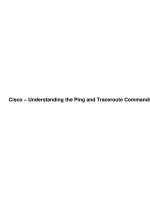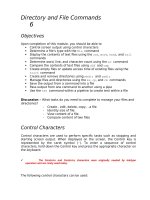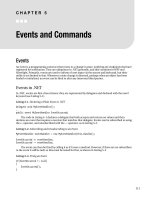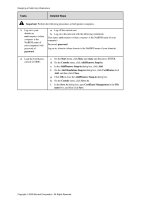Key Commands
Bạn đang xem bản rút gọn của tài liệu. Xem và tải ngay bản đầy đủ của tài liệu tại đây (92.25 KB, 1 trang )
DLSW+
Key Commands Shows and Debugs
Basic DLSW+, Ethernet with TCP
Interface ethernet 0
Bridge-group 1
Interface serial 0
Ip address 10.1.1.1 255.255.255.0
Dlsw local-peer peer-id 10.1.1.1 promiscuous
Dlsw remote-peer 0 tcp 10.1.1.2
Dlsw bridge-group 1
Bridge 1 protocol ieee
For Token Ring with FST (could use TCP too)
Source-bridge ring-group 200
Interface tokenring 0
Source-bridge 500 1 200
Source-bridge spanning
Interface serial 0
Ip address 10.1.1.1 255.255.255.0
dlsw local-peer peer-id 10.1.1.1 promiscuous
dlws remote-peer 0 fst 10.1.1.2
Automatically attaches to ring-group, unlike
ethernet which requires a TB bridge mapping
Show dlsw reacheability
Show dlsw circuit
Show dlsw peers
Debug dlsw peers
Debug dlsw reacheability
Show dlsw circuits:
Index local addr(lsap) remote addr(dsap) State
75-00 100.5acc.5acc(F0
) 1000.500c.800d(F0) Connect
F0 indicates a NetBios connection. 04 would be SNA
Use "dlsw disable" and "no dlsw disable" to reset
Additional Commands
DLSW Border peer configuration.
On spoke routers of group 40
Dlsw local-peer peer-id 10.1.1.1 group 40 promiscuous
Dlsw remote-peer 0 tcp 10.1.1.2
On hub for group 40
Dlsw local-peer peer-id 10.1.1.2 group 40 border
promiscuous
Dlsw remote-peer 0 tcp 20.1.1.1 <- border peer for group 50
In short, spokes of an area peer with the hub through remote-
peer command. They have "promiscuous" on so that they can
accept peer connections from other spokes. The hub peers with
the hub of the next "group" through a remote-peer command, and
also has promiscuous on so that it can receive connections
from the spokes in its area.
Add to peer-on-demand routers (promiscuous) so that they have
a default MTU of 1500. This is important when dealing with
segments that have ethernet on one side and token ring on the
other. If only token ring, then don't worry about it
Dlsw peer-on-demand-defaults lf 1500
The "promiscuous" keywork in local-peer
definition enables the router to handle
dlsw connections from peers for which it
does not have a remote-peer mapping
TCP port 179 for connections
TCP port 2065 for DLSW+ Read
TCP port 2067 for DLSW+ Write
Spot The Issue Notes
LLC addressing: <- for access expressions..later
0x04 SNA
0x08 SNA
0x0c SNA
0xF0 NetBIOS
0x00 Null SAP
DLSW Connection Stages:
Connection setup between routers (DLSW peers)
Capabilities exchange between DLSW peers
Peer searching for MAC address or NetBIOS name
Peer circuit (end station to end station) setup
Configuration types( in "show dlsw peers"):
Conf :When both sides have remote-peer statemnts
Prom :One has remote-peer, other has promiscuous
Pod :Peer on demand.
• When using RSRB, virtual-ring number MUST be
identical across the board. Not required for
DLSW, but always a good practice to do so.
• DLSW+ has automatic local-ack. When using
RSRB, if you wish to have local
acknowledgements, use the "local-ack" keywork
in the "source-bridge remote-peer"
definition.
• Make sure that no access-list blocks dlsw!
Traffic!
• Be careful when using DLSW and then NAT. When
a connection is established (2 way), RFC says
that one side (the side with the highest ip
address) must disconnect on port 2065. NAT:
172.10.1.1->NAT->123.10.1.19->DLSW->123.110.5.10
To both end stations, each thinks they have the
higher IP address, so both disconnect. NAT onto a
higher IP address than the neighbor! This solves
the problem.









